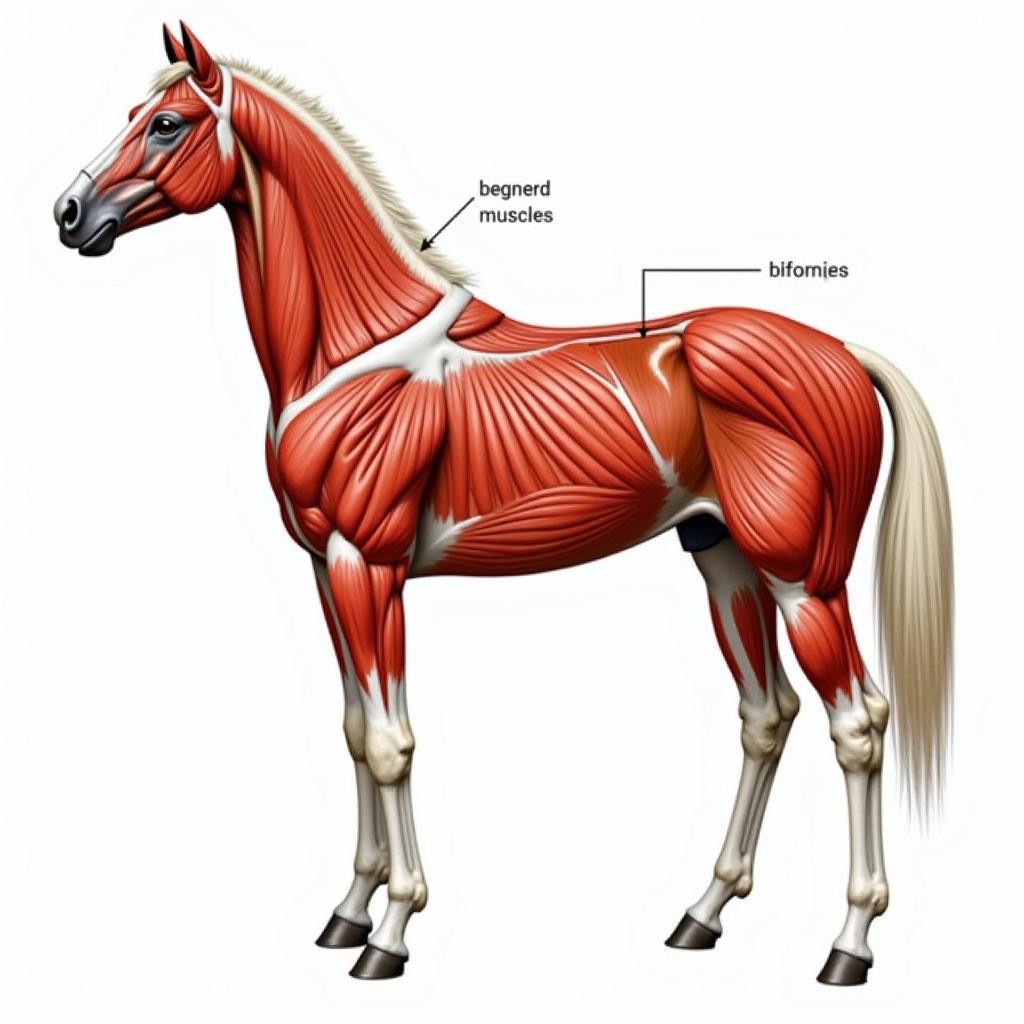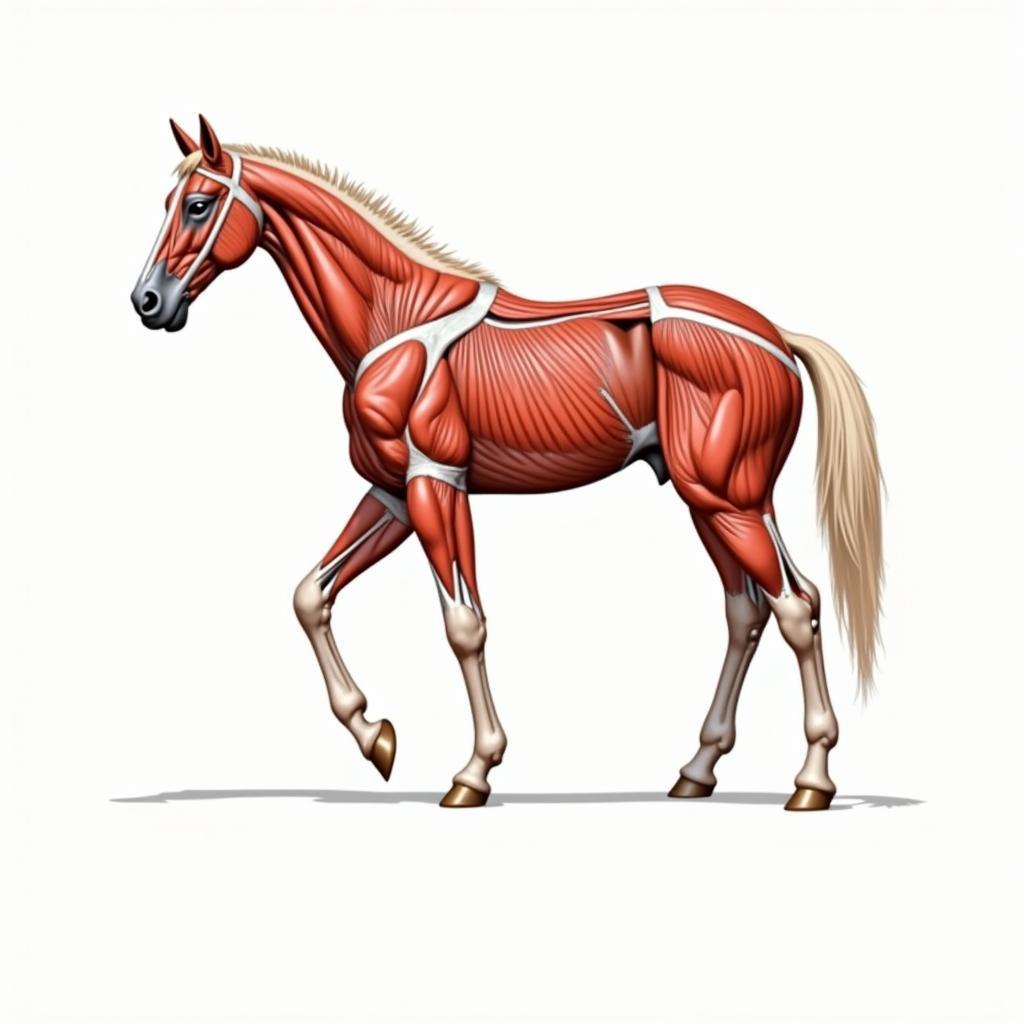The Horse Muscular System is a marvel of natural engineering, enabling these magnificent animals to perform incredible feats of strength, speed, and agility. From powerful sprints to graceful dressage movements, every action a horse performs relies on the intricate interplay of hundreds of muscles working in perfect harmony. Understanding this complex system is crucial for any horse owner or enthusiast. It’s the key to effective training, injury prevention, and ensuring the overall well-being of your equine companion.
Muscles are the engine of motion, converting chemical energy into mechanical work. In horses, this translates to everything from the subtle flick of an ear to a thundering gallop.  Horse Muscular System Overview
Horse Muscular System Overview
The Complexity of the Equine Muscular System: A Deeper Dive
The horse possesses over 700 skeletal muscles, comprising approximately 60% of its total body weight. These muscles are categorized into three main types: skeletal, smooth, and cardiac. Skeletal muscles, the focus of this article, are responsible for voluntary movement and are attached to bones by tendons. They are what allow a horse to move its limbs, head, and neck. Smooth muscles control involuntary functions like digestion and breathing, while cardiac muscle makes up the heart. Within the skeletal muscle group, there are two further classifications: Type I (slow-twitch) and Type II (fast-twitch) muscle fibers. Type I fibers are crucial for endurance activities, providing sustained, low-intensity power. Type II fibers, on the other hand, are responsible for bursts of speed and power but fatigue more quickly. The proportions of these fiber types vary depending on the breed and individual horse, influencing their athletic capabilities. For instance, a thoroughbred racehorse will have a higher percentage of Type II fibers, while a draft horse will have more Type I. The muscular system of the horse plays a vital role in their athletic performance.
Key Muscle Groups and Their Functions
The horse’s muscular system can be broadly divided into several key groups, each serving a specific purpose.
- Neck and Shoulder Muscles: These muscles are responsible for head and neck movement, balance, and initiating forward motion. Strong neck and shoulder muscles are essential for collection and performance in various disciplines.
- Back and Abdominal Muscles: These muscles provide core stability, support the rider’s weight, and are crucial for power transmission from the hindquarters to the forehand.
- Hindquarter Muscles: The hindquarters are the horse’s powerhouse, generating the propulsive force for movement. The gluteal muscles, hamstrings, and quadriceps are key players in this group.
- Forelimb Muscles: These muscles primarily support the horse’s weight and absorb concussion during movement. They also contribute to steering and balance.
How Does the Horse Muscular System Work?
Muscles contract and relax in response to signals from the nervous system. When a muscle contracts, it shortens, pulling on the attached bones and causing movement. This process requires energy, derived from the breakdown of nutrients like carbohydrates and fats. Adequate nutrition, particularly focusing on protein and essential amino acids, is critical for building and maintaining healthy muscle tissue. You might want to consider vitamin e supplements for horses for optimal muscle health.
Common Muscular Problems in Horses
Just like human athletes, horses are susceptible to various muscle-related injuries and conditions, including:
- Strains and Sprains: Overexertion or trauma can cause damage to muscle fibers or tendons, resulting in pain, swelling, and lameness.
- Tying-Up (Exertional Rhabdomyolysis): This condition causes muscle cramping and stiffness, often triggered by intense exercise. Learn more about managing pain and discomfort by exploring suitable ace dosage for horses.
- Muscle Atrophy: Lack of use or nerve damage can lead to muscle wasting and weakness.
“Understanding the specific needs of your horse, based on breed, age, and workload, is key to developing a tailored exercise and nutrition plan that promotes optimal muscular health,” says Dr. Emily Carter, DVM, specializing in equine sports medicine.
 Horse Leg Muscles Diagram
Horse Leg Muscles Diagram
Conclusion
The horse muscular system is a complex and fascinating subject. A thorough understanding of its structure and function is essential for anyone involved in the care and training of horses. By appreciating the intricate workings of this system, we can better equip ourselves to ensure the health, well-being, and peak performance of these incredible animals. Remember, proper conditioning, nutrition, and injury prevention are crucial for maintaining a healthy muscular system horse.
“Regular veterinary checkups and attention to early signs of muscle problems are essential for preventing long-term issues,” adds Dr. Carter.
FAQ
- What are the main types of muscle in a horse?
- How many muscles does a horse have?
- What is the function of the gluteal muscles in a horse?
- What are some common muscular problems in horses?
- How can I keep my horse’s muscles healthy?
- What are slow-twitch and fast-twitch muscle fibers?
- What role do tendons play in the horse muscular system?
Common Situations and Questions:
- My horse seems stiff after exercise. What could be wrong?
- How can I tell if my horse has pulled a muscle?
- What are the best exercises for strengthening my horse’s back muscles?
- How can I improve my horse’s topline?
Further Exploration on Justus Horses USA:
- Explore our detailed horse diagram labeled for a comprehensive visual guide.
Need Help?
Contact us at Phone Number: 0772127271, Email: [email protected] Or visit our address: QGM2+WX2, Vị Trung, Vị Thuỷ, Hậu Giang, Việt Nam. We have a 24/7 customer service team.